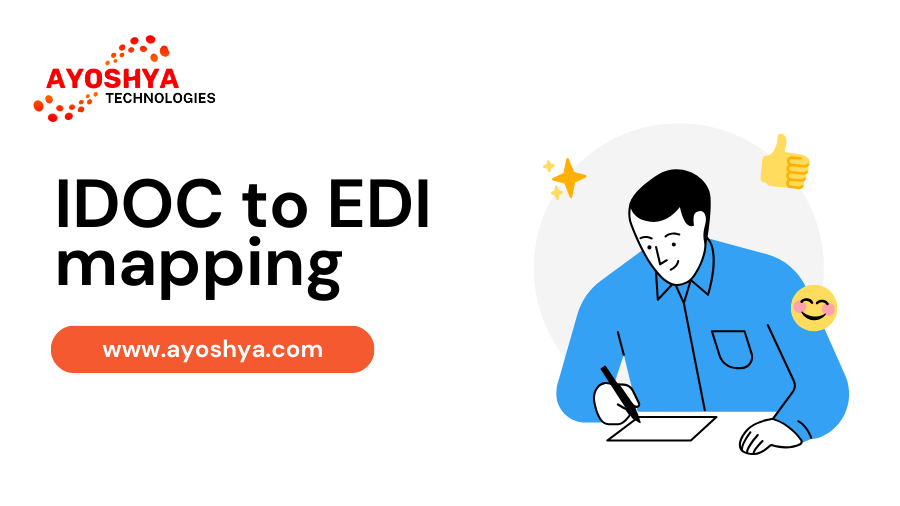idoc to edi mapping
In the dynamic world of data exchange, bridging the gap between internal systems and external trading partners often requires navigating the intricacies of Electronic Data Interchange (EDI). For SAP users, IDocs (Intermediate Documents) serve as a crucial medium for data transfer, but ensuring seamless communication with EDI standards necessitates efficient mapping techniques. This in-depth blog delves into the world of IDoc to EDI mapping, providing a comprehensive guide to understand the concepts, explore mapping methods, and unlock the potential for streamlined data exchange.
Demystifying the Landscape: What is IDoc to EDI Mapping?
- IDocs: Standardized electronic documents within SAP encapsulating data for exchange with other systems.
- EDI: Standardized electronic communication format for exchanging business documents between organizations.
- IDoc to EDI Mapping: The process of transforming data structure and format within an IDoc to comply with the specific EDI standard required by the trading partner.
Why is IDoc to EDI Mapping Important?
- Ensures Accurate and Secure Data Exchange: Mapped data adheres to predefined formats and protocols, minimizing errors and data inconsistencies.
- Improves Business Efficiency: Automates data exchange, reducing manual intervention and accelerating business processes.
- Enhances Partner Collaboration: Enables seamless communication and data synchronization with various trading partners.
- Reduces Costs: Streamlines processes and minimizes errors, leading to cost savings through increased efficiency.
Exploring the Mapping Landscape: Key Methods and Tools:
1. Manual Mapping:
- Direct coding: Writing custom ABAP code to manipulate data and format it according to the EDI standard.
- Pros: Flexible and customizable for complex mappings.
- Cons: Time-consuming, resource-intensive, and prone to errors.
2. Graphical Mapping Tools:
- Visual representation: Drag-and-drop interface for mapping IDoc segments to EDI segments.
- Pros: User-friendly, reduces coding errors, and improves maintainability.
- Cons: Limited flexibility for complex mappings, may require additional configuration.
3. Pre-Configured Mappings:
- Ready-made mappings: Utilize industry-standard or vendor-specific pre-built mappings.
- Pros: Quick and easy to implement, saves development time.
- Cons: Limited customization, may not perfectly fit specific needs.
4. Hybrid Approach:
- Combining methods: Leverage pre-built mappings for standard segments and manual coding for specific needs.
- Pros: Offers balance between efficiency and flexibility.
- Cons: Requires expertise in multiple methods and careful integration.
Choosing the Right Mapping Approach:
- Complexity of Data: Consider the level of data transformation and customization required.
- Volume of Transactions: Evaluate the frequency and size of data exchanges.
- Internal Resources: Assess your team’s expertise and available development resources.
- Budgetary Constraints: Compare the cost of different mapping tools and development efforts.
Best Practices for Effective IDoc to EDI Mapping:
- Standardized Naming Conventions: Ensure consistent naming for fields and segments across mappings.
- Thorough Testing and Validation: Rigorously test mappings to ensure data accuracy and compliance.
- Documentation and Version Control: Clearly document mapping logic and maintain version history for tracking changes.
- Monitoring and Auditing: Regularly monitor data exchange processes and maintain audit trails for traceability.
The Future of IDoc to EDI Mapping:
- Cloud-Based Solutions: Leveraging cloud platforms for mapping tools and managed services.
- AI-powered Mapping: Utilizing machine learning to automate mapping tasks and adapt to data variations.
- Standardization and Interoperability: Streamlining standards and improving interoperability between different EDI formats.
- Security Enhancements: Implementing advanced security measures to protect sensitive data during exchange.
By understanding the intricacies of IDoc to EDI mapping, choosing the appropriate methods, and adopting best practices, you can unlock the full potential of seamless data exchange between your SAP systems and trading partners. Remember, effective mapping is not just about technology; it’s about enabling efficient communication and collaboration within the broader business ecosystem.
I hope this comprehensive blog empowers you to navigate the world of IDoc to EDI mapping with confidence!
You may be interested in:



